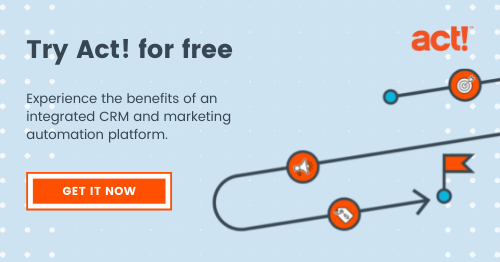
Is your business using separate apps and software to fulfill your customer relationship management needs? If so, you’re probably spending more time and money managing a complex setup than you’d like — without getting the results you want.
An integrated CRM and marketing automation platform can help you expand and energize your customer relationships. By capturing all of your data in one place, you gain better marketing intelligence to drive new offerings, loyalty programs, and promotions that grow your business. And when your CRM and marketing automation systems are fully integrated, you can take advantage of more advanced progressive profiling and automated workflows to accelerate the sales process and build more loyal customer relationships.
The power of sales and marketing fusion
Today, the traditional lines between sales teams and marketing teams have nearly evaporated, partly because the way customers seek information has changed dramatically in this digital age. Customers expect to find the products and services they want at any given moment — and they expect a similar experience with customer service as well.
As a result, CRM software needs to enable new ways of doing business. This means that today’s CRM platforms must have the functionality to support the entire customer lifecycle at every stage: from acquisition to retention, and across both digital and human interactions in a seamless workflow.
Many small businesses often rely on a pool of software solutions to manage all of their digital marketing and sales operations. But as these operations become more blended and intertwined, a fully integrated CRM and marketing automation platform is required to support all of them with a single point of control.
Marketing intelligence isn’t just for big business anymore
With an integrated marketing automation and CRM platform, you don’t have to be a pro to easily generate powerful insights from all of your data. The key is to capture that information in a closed-loop marketing workflow that provides a single source of truth to help you make deeply informed business decisions and:
- save time and improve efficiencies for all team members by hosting data in one place
- reduce costs by paying for one platform instead of multiple products
- shorten your learning curve and your prospect’s sales cycle with a unified and seamless user experience
- increase new qualified leads and repeat business with the optimization of your customer lifecycle experience
An integrated marketing automation and CRM solution will:
1. Capture more leads to grow your prospect lists.
Do you have great website traffic, but don’t know who your visitors are or how to get them to convert? A great way to find out is to create forms on your website to capture visitor information in exchange for valuable content that you provide. Sound complicated? Not really. Something as simple as offering a newsletter signup can help you stay connected with people who visit your website. However, many small businesses and salespeople overlook simple yet effective tools such as lead capture forms to grow their prospects.
You can use marketing automation software to easily create and add lead capture forms to your website and instantly record that data in your integrated CRM database. This data makes it easy to set up quick follow-ups like phone calls, emails, or nurture campaigns. By capturing this vital information in one place, you’ll be able to track all of your sales and marketing interactions so you can see real-time results and trends across entire campaigns as well as individual prospects and customers.
Read how landing pages can help you capture website visitor information and learn more about lead scoring in this Complete Guide to Lead Management.
2. Automate prospect nurturing.
Meaningful engagement with your prospects doesn’t just depend on having accurate contact information. You also have to follow up with your leads and deliver the right communication, pricing, or offer at just the right moment. This can be a challenge for any business, but small businesses with limited resources often find it more difficult to manually provide meaningful customer engagements that drive conversions. This is where an integrated marketing automation and CRM solution will improve your sales and marketing efforts. You simply set up your email marketing campaigns once, and then let the software do the work by:
- sending your prospects the right follow up messages at the perfect time
- providing notifications and reminders to you when a manual touchpoint is scheduled
- capturing and tracking engagement in your CRM platform
- displaying all relevant information in an easy-to-view dashboard
Without integrated systems and automated workflows, you may be slowing down your sales cycle by spending too much time managing your data instead of finding leads and closing deals. To improve your marketing strategy, sales pipeline, and customer satisfaction, it’s important to stop wasting valuable time exporting and importing lists across various platforms that don’t talk to each other.
By integrating CRM and marketing automation in one single solution, you can send automatic follow-ups based on prospect criteria and activities you customize and fine-tune. This helps you nurture leads and convert new prospects through your sales funnel into customers more quickly and efficiently.
Learn how deep customer relationships will help you outperform your competition.

3. Improve sales forecasting and conversion rates.
If critical customer data is missing, outdated, or inaccurate, it can lead to poor customer experiences and potentially impact your metrics and sales projections. Without accurate data, you can miss out on vital customer conversion and sales opportunities.
An integrated marketing automation and CRM system lets you track all sales and marketing interactions in one place — from initial contact to every human touchpoint along the way — so you can see real-time results and trends across the individual customer lifecycle as well as your marketing campaigns as a whole. Not only does this drive lead generation and support more accurate sales projections, you also get the intelligence needed to nurture and grow customer relationships. This is because everyone on your team can act on the most current and accurate information about every customer, whether it’s helping with a service issue, understanding a pain point, or following up on a sales opportunity.
Check out this 7 Step Sales Process to learn how to improve conversions.

4. Deliver ongoing customer value.
Once you’ve acquired a customer, it’s important to keep them engaged by delivering exceptional service and relevant communications to let them know you value their business. Marketing automation tools can help you streamline this process by triggering automatic email campaigns, scheduling follow-up phone calls, or sending relevant surveys based on purchase histories. By using automation in this way, you can maintain a personalized human connection to foster your customer relationships.
However, because many small businesses often use a mix of unintegrated sales and marketing solutions, it can be hard to keep track of customers as businesses grow because these ad hoc systems don’t scale easily. A fully integrated solution grows with you and gives you a 360-degree view of the entire customer lifecycle enabling you to improve your customer experiences over the long term.
Learn more about marketing automation.

5. Retain customers to grow your business.
Customer data undoubtedly changes over the course of the customer lifecycle. Whether it’s contact information, preferences, or product or service upgrades, you have to make sure your customer service and sales reps always have the most current data at their fingertips to provide the best service and improve customer retention.
For instance, you can use marketing automation to set reminders to contact customers based on certain criteria, such as new products and service offerings. A financial planner can use this capability to ping clients when it’s time for an annual account review. Or perhaps the company wants to generate attendees for their free retirement webinar aimed at current clients and prospects. The planner can target an email campaign to recipients who meet certain criteria, such as age, size of an investment portfolio, and data entered on a lead capture form. After the webinar, sales reps can reach out to attendees to further nurture leads or offer additional investment products and services to existing clients based on their investment history and financial goals — all of which are captured in the CRM platform.
Read this article to learn about the value of customer retention.

Wrapping up & next steps
Ultimately, the goal of integrated marketing automation and CRM is to help your business do more with less. You can more efficiently engage prospects and customers so you don’t have to increase headcount or work longer hours to achieve the same goals.




